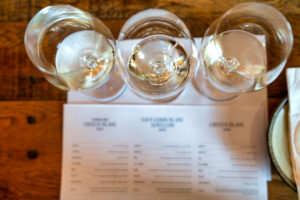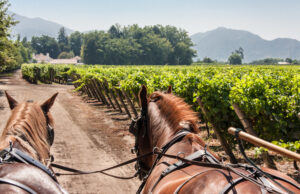When it comes to wine, a definitive two worlds — Old and New — describe the Old World as Europe and the Middle East, where vitis vinifera, or the wine grape, originated, and the New World as countries which found success in winemaking long after these regions. A few key New World regions include the United States (primarily California, Oregon and Washington), Chile, Argentina, Australia, New Zealand and South Africa.

PHOTO: © GIOVANNI GAGLIARDI | DREAMSTIME.COM
For many years, New World wines were categorized as fruitier with higher alcohol as opposed to the Old World’s lower-alcohol, lighter-bodied wines across the board. Yet these definitions are certainly shifting, as is the perspective around some of these regions; the best way to learn more about this, and wine in general, is by visiting different winemaking zones to better understand their narrative.
Wine tasting around the world also teaches by example. When you walk the rows of vines and bend down to compare the chalky soils beneath your feet to the feel of the clay soils from the day before, you’re more likely to understand and thus recognize why certain wines taste the way they do.
The same applies to sipping wine in the high-altitude vineyards of Sonoma Valley, where San Pablo Bay cools the Chardonnay grapes. Feeling this breeze and breathing the salt-infused air engages the senses to recognize the characteristics that end up in the glass. Suddenly you can perceive the salinity and minerality of a Sonoma Chardonnay. This applies as well to sipping Champagne in the eponymous region of France, where walking the vines in this celebrated region showcases the seven types of grapes authorized for use in Champagne. The most popularly blended grapes are Chardonnay, Pinot Noir and Meunier. A hands-on experience helps you recognize the different flavors and textures that lend themselves to different Champagne styles. Generally, Chardonnay brings freshness and minerality, Pinot Noir adds body, and Pinot Meunier imbues structure and texture.

PHOTO: © ND3000 | DREAMSTIME.COM
If you wish to learn more about your beloved styles of wines or seek to explore new varieties to add to your favorites list, it’s time to book a tasting. Following, discover some of the best regions for tasting wine around the world.
FRANCE
As one of the most important wine producers in the world, renowned for pioneering certain traditions that inspired modern- day techniques, France boasts no shortage of wine regions. Certainly French-fond oenophiles will want to reserve a tasting in the most prominent regions of Bordeaux, Burgundy, Champagne, the Loire Valley and the Rhône, but there are also less trodden tasting trails. These include Alsace, which hosts the country’s oldest wine route (established in 1953); the Jura Wine Road; and the Languedoc. Rosé aficionados will want to spend a few days in Provence, the southern region that hugs the Mediterranean and proves the quintessential destination for sipping the blush-hued wine.
ITALY
As in France, wine is part of Italy’s culture. You could spend weeks exploring the vast offerings of grapes from Italy’s northernmost border to the tip of the boot and beyond to the encompassing islands. For imbibers who think Italian wines are limited to the familiar Chianti, Barolo, Amarone, Pinot Grigio, Verdicchio and Prosecco, there are more than 2,000 indigenous grapes, with about 400 of those used in commercial production. This means even in the most popular tasting rooms of Italy’s most famed growing regions — Tuscany, Piedmont, Umbria, Veneto — you’ll still meet (and likely fall in love with) a new grape variety. Then, as you venture farther outside these mainstream destinations, you’ll learn about even rarer grapes such as Verdeca, the refreshing white wine in Puglia; the fragrant red Cannonau in Sardinia; and the volcanic Nerello Mascalese, one of Sicily’s signature red varietals that’s even more delectable when a winemaker serves it slightly chilled under the island’s blazing sun.
PORTUGAL
If you plan to visit Portugal to taste its globally renowned fortified wine, Port, start in the Douro Valley. A tasting here allows you to truly savor part of history; the Douro Wine Region is the oldest demarcated wine region in the world and a UNESCO World Heritage site. A flurry of other regions come with their own history, from northern Minho where the zesty, slightly effervescent Vinho Verde is produced, to eastern Beira’s prolific Touriga Nacional and southern Alentejo’s full-bodied white Antão Vaz. Even further south, the Algarve serves up Negra Mole, a distinctly luscious red. The island production shines too: Madeira’s sweet fortified wines are often overlooked for the previously mentioned Port but worth veering out of your way. And the Azores beckon with traditional, old vines including Arinto dos Açores, Verdelho and Terrantez do Pico.
SPAIN
Rioja and Jerez may spring to mind for anyone remotely familiar with Spanish wine regions; however, as recognizable as the names may be, wine tastings in Spain are still somewhat niche in comparison to its neighboring countries’ wine regions. That’s what makes wine tastings in Spain particularly special — there’s a sense of being in the know here. Still, it’s worth venturing to even less recognized regions like Priorat, emerging for its full-bodied red wines; Cariñena (both the designation and the wine) in the northern Aragon region; and the Canary Islands, where visitors awe at the special viticulture — vineyards in Lanzarote mimic the moon’s surface, with otherworldly craters surrounding the vines as protection from the islands’ harsh winds.
UNITED STATES AND CANADA
California’s Napa Valley undoubtedly reigns as the United States’ prized wine region — so much so, it offers a Wine Train to transport wine enthusiasts for a day of tasting without the worry of driving or arranging a driver. First-time visitors will want to sample several of the area’s star, Cabernet Sauvignon, to understand how the wine’s style changes based on its growing conditions, from the cool climate of Coombsville to the warmer Calistoga AVA.
Washington state is also generally revered for its Cabernet Sauvignon, particularly in the Yakima Valley. In Oregon the Willamette Valley tops lists for its Pinot Noir and Chardonnay, but travel south to the Rogue Valley, and the reward is its unique Tempranillo (a Spanish variety that flourishes here).
If you seek something even less well-known, seek out the emerging wine pockets in New York, Texas and Colorado. Across the U.S.–Canada border, the Okanagan Valley awaits unsuspecting oenophiles; the best part about tasting in the Okanagan is you’ll likely try a bottle — popular varieties include Chardonnay, Riesling, Pinot Noir and Merlot — the majority of the world hasn’t tasted due to limited exports.
CHILE AND ARGENTINA
There’s nothing quite like swirling a glass of wine in the shadow of the Andes Mountains. Tastings in Mendoza, Argentina, and the Colchagua Valley of Chile deliver this reward. Both countries appeal for their bold, red wines — Malbec in Argentina offers leather and coffee notes, while Carménère in Chile presents a characteristic peppery spice.

© ALEXANDRE FAGUNDES DE FAGUNDES | DREAMSTIME.COM
AUSTRALIA AND NEW ZEALAND
Australia appeals to red wine drinkers with its prominent production of Shiraz (Syrah). Key areas include the rolling hills of the Barossa Valley and the coastal cliffs of Margaret River. Neighboring New Zealand is a white wine drinkers’ paradise with the Marlborough region’s zippy Sauvignon Blanc and, in recent years, emerging production of Albariño, a native Spanish grape. Off the coast of Auckland, winemakers on Waiheke Island craft some stellar Bordeaux blends and offer a chance to taste wines with sweeping ocean views.
Read This Next
What to Expect at Vermont’s Om Festival
Trends / Health & Wellness
Apr 3, 2025#TrazeeTravel
Insta FeedDestinations / North America
Apr 15, 2025What to Expect from This Year’s Miami Attraction & Museum Months
Miami welcomes the return of its Attractions & Museums Months this spring, highlighting the city’s top cultural institutions, outdoor attractions and hidden gems. This two-month program gives visitors the chance to both discover Miami’s art and cultural heritage and snag great discounts, deals and perks.
Sponsored Content
AmaWaterways’ Specialty River Cruises
When you embark on a river cruise with award-winning AmaWaterways, unpack once and step aboard a world of unparalleled experiences. With enriching excursions, exquisite locally sourced food and wine, nightly entertainment and more included in the fare, you will learn why AmaWaterways has the most returning guests out of any river cruise line.
Slideshow
Apr 15, 20256 Must-Visit Egyptian Tomb Sites
It’s time to start dreaming of your next trip. Here’s six must-visit Egyptian tomb sites.
Hotel
Apr 15, 2025Himalayan Resort Unveils Innovative Initiatives and Programs
Ananda in the Himalayas celebrates its 25th anniversary this year. To mark the celebration, this luxury wellness property announced new programs and innovations.
Sponsored Content
Madrid: The Charm of an Authentic City
They say Madrid is in vogue for many reasons: its lifestyle, its heritage, its cuisine and all of its new attractions. And it’s true, because Madrid is on the radar of travelers looking for a cutting-edge destination that still holds onto its essence. Join us as we explore its charms.
Hotel
Apr 14, 2025New Places to Stay in Palm Springs
Traveling to Palm Springs sometime soon? Book a stay at one of the destination’s new, independent and small properties.

ShareThis